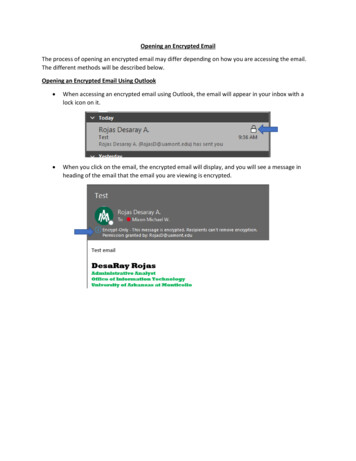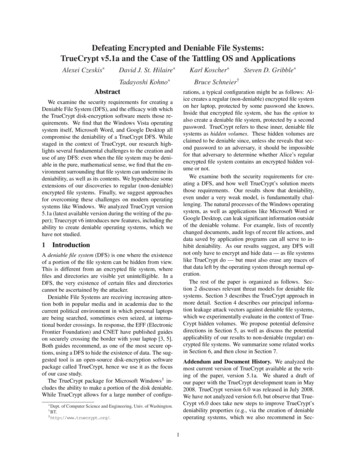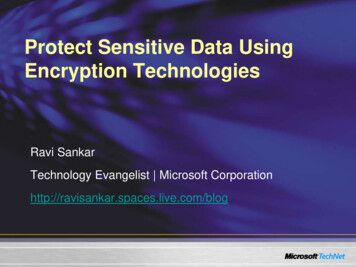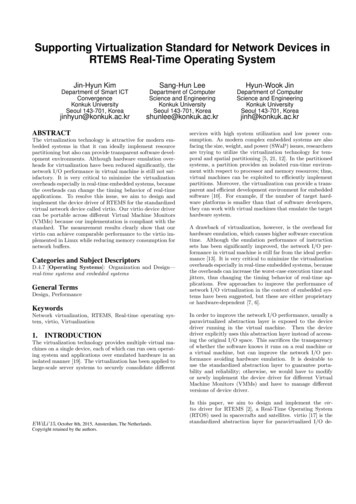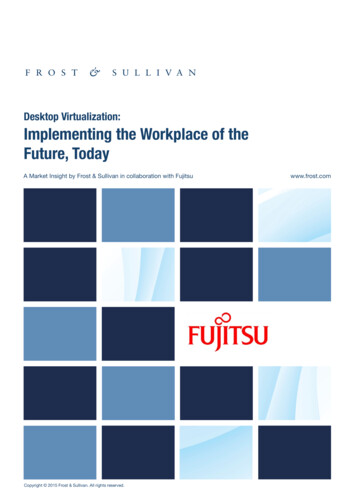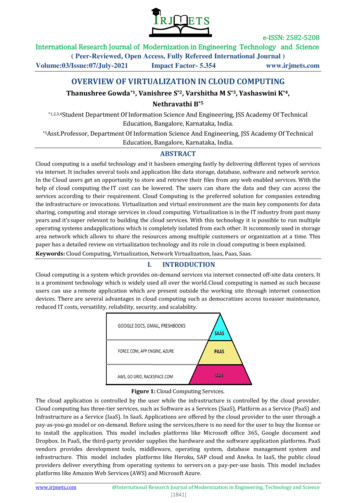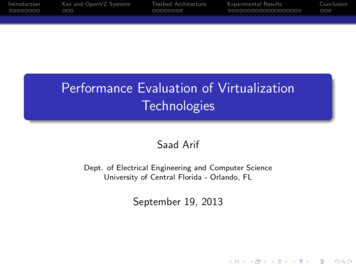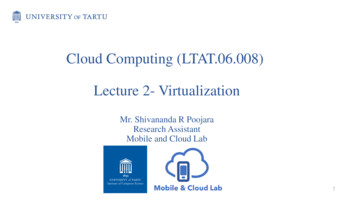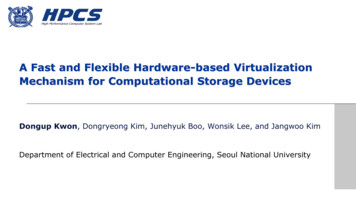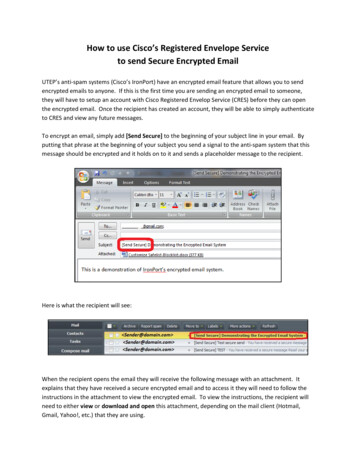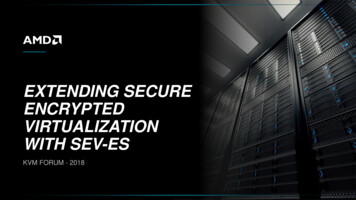
Transcription
EXTENDING SECUREENCRYPTEDVIRTUALIZATIONWITH SEV-ESKVM FORUM - 2018
SEV ReviewAGENDAWhat is SEV-ESHow SEV-ES worksPatch Status2 AMD SECURE ENCRYPTED VIRTUALIZATION 2018
SEV REVIEW AMD Secure Memory Encryption / AMD Secure Encrypted Virtualization Hardware AES engine located in the memory controller performs inline encryption/decryption ofDRAMMinimal performance impact Extra latency only taken for encrypted pagesNo application changes requiredEncryption keys are managed by the AMD Secure Processor and are hardware isolated Not known to any software on the CPUAES-128 EngineDRAM3 AMD SECURE ENCRYPTED VIRTUALIZATION 2018Root of TrustAMDSecureProcessor
SEV REVIEW ApplicationsApplicationsApplicationsContainer Protects VMs/Containers from each other, administrator tampering,and untrusted HypervisorVM One key for Hypervisor and one key per VM or VM/Sandbox withmultiple containersSandbox/ VMOS/Hypervisor Cryptographically isolates the hypervisor from the guest VMsKey Integrates with existing AMD-V technologyKeyKey AES-128 Engine System can also run unsecure VMsDRAMAMD Secure Encrypted VirtualizationTraditionalVirtualization4 AMD SECURE ENCRYPTED VIRTUALIZATION 2018HypervisorGuestHypervisor Guest Guest
SEV REVIEW Linux Kernel EDK II / OVMF 2.12Libvirt 52018Qemu 4.15 - Run as an SEV guest4.16 - Launch an SEV guest4.5 AMD SECURE ENCRYPTED VIRTUALIZATION 2018
WHAT IS SEV-ES SEV: Secure Encrypted Virtualization Provides encryption of guest memorySEV-ES: Secure Encrypted Virtualization – Encrypted State Provides additional security above memory encryptionGuest register state is encrypted with guest encryption key and integrity protected Guest must explicitly share register state with the hypervisor Guest-Hypervisor Communication Block (GHCB)Protects the guest register state from the hypervisor 6Only the guest can modify its register stateAdds additional protection against VM state related attacks (exfiltration, control flow, rollback) AMD SECURE ENCRYPTED VIRTUALIZATION 2018
HOW SEV-ES WORKS Guest register state protection Register state is initialized with known state (Initial Processor State)Register state is encrypted and measured as part of the SEV LAUNCH processRegister state becomes part of the SEV LAUNCH measurementIntegrity check performed on each VMRUNVMSAWorld switches now swap ALL register stateSegment StateVMCB under SEV-ES Control Area (VMCA) and Save Area (VMSA) now separated 7VMCA now points to VMSAVMSA extended to save more state AMD SECURE ENCRYPTED VIRTUALIZATION 2018Control StateGPR StateFPU State
HOW SEV-ES WORKS New VMEXIT types Automatic Exit (AE) Non-Automatic Exit (NAE) Generates a VMM Communication Exception (#VC)Guest determines what register state to share in the GHCBGuest issues new VMGEXIT instruction which causes an AE with exit code 0x403Guest updates register state with hypervisor supplied resultsNew Control Register write traps 8Events that occur asynchronously with respect to guest execution (e.g. interrupts)Events that do not require guest register state (e.g. HLT instruction)CR0 – CR15, EFER writes generate an AE after the control register has been modifiedNew value of the register is saved in EXITINFO1Hypervisor can use this to track CR changesOnly supported for SEV-ES guests AMD SECURE ENCRYPTED VIRTUALIZATION 2018
HOW SEV-ES WORKS Guest-Hypervisor Communication Block (GHCB) Allows guest hypervisor communication of the state needed to satisfythe guest service requestShared (un-encrypted) page between the hypervisor and the guest Guest sets the physical address of the GHCB in an MSRHypervisor obtains guest physical address from the VMCB Control AreaGHCB specification (in process) Define the format of the GHCBDefine a minimum set of supported NAE exitsDefine the required state to be provided and returned on VMGEXITDefine VMGEXIT definitions (SW EXITCODE, SW EXITINFO1,SW EXITINFO2) Define methods required for special scenarios 9Re-use current SVM exit information where possible along with SEV-ES softwaredefined exit informationAP booting, NMI handling, etc. AMD SECURE ENCRYPTED VIRTUALIZATION 2018HypervisorGHCB#VCHandlerGuest
HOW SEV-ES WORKS New VMM Communication Exception (#VC) Always thrown for an SEV-ES guest when an NAE event occursError code is equal to the VMEXIT code of the NAE event#VC handler Prepares the GHCB based on the error code Issues VMGEXIT instruction to generate an AE event (REP VMMCALL)Examines the GHCB on completion of VMGEXIT 10Copies required input register state to the GHCBSets SW EXITCODE, SW EXITINFO1, etc.Checks SW EXITINFO1 for indication of success or failure On failure, invoke requested exception (e.g. RDMSR of un-supported MSR)Copies required output register state from the GHCB AMD SECURE ENCRYPTED VIRTUALIZATION 2018
HOW SEV-ES WORKS GuestCPUIDCPU HWHypervisorGuest triggersVMEXITconditionSend #VC toguestRead ErrorCode CPUIDWrite CPUID EXIT to GHCBCopy RAX to GHCB#VC handlercopies state toGHCBVMGEXITSave/encryptguest stateLoad HV stateHV handlesexitVMRUNSave HV stateLoad/decryptguest stateCopy RAX/RBX/RCX/RDXto register state#VC handlermodifies stateIRET11 AMD SECURE ENCRYPTED VIRTUALIZATION 2018Read GHCB see CPUID EXITRead RAX, emulate CPUIDWrite RAX/RBX/RCX/RDX to GHCB
CHALLENGES Early Boot Before CR4.PAE 1, all pages are private (encrypted) Unable to mark the GHCB as shared (un-encrypted)Need to avoid any NAE exits before marking the GHCB as sharedEncryption mask is normally determined using CPUID instruction – now causes a #VC Requires the Hypervisor to communicate the encryption bit position to the guest 12Hypervisor VMCB Control Area GHCB GPA field (offset 0x00a0) / Guest GHCB MSR (0xc0010130)Format defined by GHCB specification AMD SECURE ENCRYPTED VIRTUALIZATION 2018
CHALLENGES Early Boot SMP Support, NMI Support, others 13Documented in the GHCB specification AMD SECURE ENCRYPTED VIRTUALIZATION 2018
CURRENT STATUS Currently have Proof-of-Concept patches for: EDK2 / OVMF Linux Booting multi-vCPU guestNeed to address some early boot challengesGHCB Specification 14Booting multi-vCPU guest through to UEFI shell / GRUBUnder review, available publicly AMD SECURE ENCRYPTED VIRTUALIZATION 2018
REFERENCES Links to the following reference material can be found at https://developer.amd.com/sev White Papers & Specifications Protecting VM Register State with SEV-ES Whitepaper Guest Hypervisor Communication Block Specification AMD64 Architecture Programmer’s Manual Volume 2: System Programming 15Sections 7.10, 15.34 and 15.35 AMD SECURE ENCRYPTED VIRTUALIZATION 2018
DISCLAIMER16 The information contained herein is for informational purposes only, and is subject to change without notice. While every precaution has been taken in thepreparation of this document, it may contain technical inaccuracies, omissions and typographical errors, and AMD is under no obligation to update or otherwisecorrect this information. Advanced Micro Devices, Inc. makes no representations or warranties with respect to the accuracy or completeness of the contents ofthis document, and assumes no liability of any kind, including the implied warranties of noninfringement, merchantability or fitness for particular purposes, withrespect to the operation or use of AMD hardware, software or other products described herein. No license, including implied or arising by estoppel, to anyintellectual property rights is granted by this document. Terms and limitations applicable to the purchase or use of AMD’s products are as set forth in a signedagreement between the parties or in AMD's Standard Terms and Conditions of Sale. AMD, the AMD Arrow logo, and combinations thereof are trademarks of Advanced Micro Devices, Inc. Other product names used in this publication are foridentification purposes only and may be trademarks of their respective companies. 2018 Advanced Micro Devices, Inc. All rights reserved. AMD SECURE ENCRYPTED VIRTUALIZATION 2018
4 AMD SECURE ENCRYPTED VIRTUALIZATION 2018 Protects VMs/Containers from each other, administrator tampering, and untrusted Hypervisor One key for Hypervisor and one key per VM or VM/Sandbox with multiple containers Cryptographically isolates the hypervisor from the guest VMs Integrates with existing AMD-V technology
